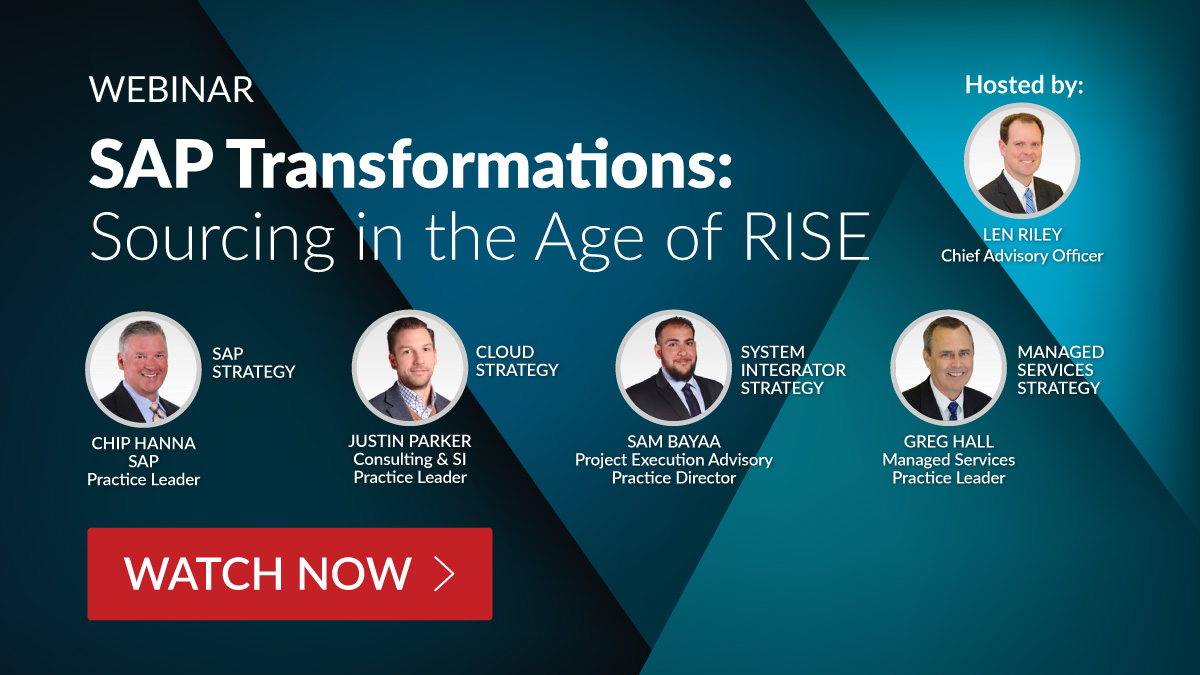- Justin Parker
- Reading Time: 7 minutes

In the advent of RISE with SAP, organizations may be tempted to pit a hyperscaler’s offerings against RISE to determine the best fit for their digital transformation. But don’t be fooled – there are many dimensions and complexities that must be thought through beyond a simple comparison, and the hyperscalers may prove to hold their own against RISE.
Selecting a hyperscaler comes with adjacent and long-term implications, including impacts on existing relationships, migration services, run management services, financial incentives and contractual structures. But the hyperscalers also come with commercial, organizational, and architectural flexibility to drive your organization’s own destiny. Hyperscalers are the viable alternative to RISE and SAP’s vision of the future.
Most companies already have existing relationships with Microsoft, AWS, and Google. However, the movement of their SAP infrastructure is a major relationship and commercial inflection point. As a result, organizations are compelled to address their approach to evaluating the hyperscalers compared to SAP RISE.
While SAP is positioning RISE to work with the hyperscalers, it is crucial for organizations to understand the influence the hyperscalers have on the current state of the market. Here, I will discuss how the hyperscalers have hit prime time in the market, the front and back end of the hyperscaler’s flexible financial models, and the pros and cons of going direct to a hyperscaler versus putting your hyperscaler under a service provider to ensure your organization understands why the hyperscalers are the viable alternative to RISE with SAP.
Hyperscalers Hit Prime Time
It’s interesting that SAP introduced RISE as the hyperscalers hit prime time. It wasn’t long ago that many organizations had reservations with the public cloud. But now, in 2021, the public cloud is not necessarily just for startups, small companies, organizations that lack capital, or organizations looking to move their non-productive workloads into the cloud. Now, we’re seeing both large and small organizations relinquish any reservations they had and move whole scale to the public cloud, including large-scale ERP workloads like SAP. Even organizations that still own and have a large investment in their on-premise datacenters are now relinquishing that control and going directly to the public cloud.
Another observation that’s interesting as the hyperscalers hit prime time is what the traditional software OEMs are doing, SAP included. The OEMs are now leveraging the hyperscalers to enable a material part of their cloud strategy, allowing them to expedite their cloud roadmap and allow the hyperscalers to optimize margins along the way.
Organizations with a digital transformation roadmap who are looking to enable that roadmap are now at a crossroads: Do these organizations go with SAP, another traditional software OEM, a line of business software vendor that will help them expedite their roadmap for their overall digital transformation, or do they go with a hyperscaler, who arguably has a broader role to play?
At this point, hyperscalers are in the driver’s seat. With broader transformation roadmaps from a digital side, hyperscalers afford organizations the infrastructure, platform, and broader partner ecosystem and network to get that organization to the other side and do so for the more strategic components of their overall strategy.
Understanding the Commercial Models
Not only have the hyperscalers hit prime time, allowing the software OEMs to optimize their own margins and expedite their cloud strategies, the hyperscalers are also allowing their customers to pay for what they need, when they need it, under a pay-as-you-go model. Additionally, the hyperscalers allow for a bring-your-own-license (BYOL) approach which allows customers to maintain the benefits of their perpetual license base and avoid SAP’s push towards a subscription-based model.
These financial models essentially have two-sides – the front-end and back-end:
The Front End of the Deal: With the front end of the deal, we’re looking at the compute resources and the services you’re obtaining from the hyperscalers. At their core, each hyperscaler has their own levels of pricing algorithms. To establish your baseline discounting under these algorithms, it’s all about how much compute you are willing to commit to and over what term you are willing to make that commitment. The more compute you commit to and the longer the term of that commitment, the better your discount will be.
The hyperscalers are also offering additional discounting opportunities that allow you to drive and optimize your unit rates on an ongoing basis, whether that be upfront purchases or specific reserved instances (i.e., AWS’s compute payment plan), or other types of upfront compute-specific consumption commitments. When you have a direct relationship with your hyperscaler of choice, you are the beneficiary of that optimization, instead of a SaaS where providers keep the difference as their margin (i.e., SAP RISE).
If you are an SAP HEC customer, you know HEC is notorious for lacking transparency. You probably don’t know your unit rates on the infrastructure side, and, even if you do, you’re wondering if you’ve ever seen your unit rate go down. The answer is probably not.
Instead, what you’re seeing is the traditional software OEMs leveraging this discounting potential to optimize their unit rates over time. In this regard, the software OEMs do not differ from the hyperscalers. Rather, the difference, from SAP’s standpoint, is that as the OEMs optimize those unit rates, they keep it all to themselves and continue to optimize their overall margins instead of sharing any of that with the client.
It is also important to note that a discount with one provider does not necessarily equal the same discount with another. If one provider is giving you a greater discount than another, it is not that you must look at the base by which the discount is being provided but, rather, understand that these discounts are not all created equal. This is where the proposed infrastructure and compute resources matter.
The Back End of the Deal: With the back end of the deal, we’re looking at the investments, the credits, and other cash and prizes that the hyperscalers are providing to the market to influence customer decision-making in the hyperscalers’s direction, essentially offsetting the cost of transition.
As we’ve been supporting our clients, we’ve noticed these investments and credits are flying all over the place. They’re going directly to the customer, directly to the partner, to the customer through the partner, and any number of combinations in between. With that said, the hyperscalers are providing large-scale investments in the marketplace, and someone is benefiting from those investments. However, if no one is discussing those investments with you, there is a high likelihood you are not that someone.
Regardless of your sourcing strategy, your hyperscaler support model or how you’re approaching the market to determine how you are going to host your SAP workloads or your general environment overall, it becomes crucial that you are having direct and transparent conversations with the hyperscalers so you understand the full extent of the investments they are making available to the marketplace. Otherwise, you’re putting it in your third-party service provider’s or SAP’s hands to highlight the actual reality of these available investments or to add additional contingencies on the release of some of those investments the hyperscalers are making.
Finally, it is important to highlight the degree to which investments are being made by the hyperscalers. Before, when a customer was making a decision with HEC, SAP would give the customer the option to select whatever hyperscaler they wanted. Now, the hyperscalers are going directly to those customers and providing incentives to influence their decision on the SAP HEC side. As a result, it’s up to the customer to understand what options and opportunities are being made available, and the only way to obtain full transparency is to go to them directly and ask the question.
One key consideration to note about the migration approach and partner network as it relates to the hyperscalers is that as you make the switch from an on-premise environment or another type of data center environment to the hyperscalers, it’s not necessarily plug-and-play. Each type of hyperscaler has their own levels of accountability and approach to help their organizations get to the other side of their digital transformation.
However, the hyperscalers are not necessarily helping these organizations fully get to the other side, leaving each customer with a decision: Should you do it yourself and close the gap on your own or should you leverage one of the migration partners?
It’s no different than the court appointing you an attorney when you need it – if you need a migration partner, the hyperscalers will appoint you one, and they’ve got an extensive list of partners to choose from. But again, even when a migration partner has been appointed to you, it does not necessarily increase their level of accountability to get you to the other side and transform your environment.
Going Direct to the Hyperscalers vs. Putting the Hyperscalers Under a Service Provider
Putting aside RISE for a moment, companies deciding whether to go direct with a hyperscaler or putting a hyperscaler under a service provider requires its own evaluation process.
When you assess the pros and cons of going direct with a hyperscaler, one major con you may find is that you now own and have the contractual obligation to manage your agreement. Again, you have the opportunity to optimize your unit rates over time, but by going direct with a hyperscaler, you are now in the driver’s seat in that regard and have the responsibility to optimize your unit rates over time and maintain those optimizations.
As for the pros of going direct with a hyperscaler, you have complete transparency to the unit rates and what you’re paying for and complete transparency with the investments. You can have this transparency while still maintaining a direct relationship with the hyperscaler that then opens you up to other realms of possibilities if your digital transformation journey is broader than just SAP.
By putting your hyperscaler under a service provider, what we call the professional approach to your digital transformation, the con is that you do not necessarily have visibility into the number of investments being passed on to you. You still maintain some flexibility to stay with the hyperscaler and transition that environment over to you, but it depends on the service provider you are working with.
The biggest advantage to the professional model is that the onus of managing the unit rates and costs is on the third-party managed service provider. However, this approach does raise an important question: Does your contract obligate the service provider to continuously optimize the unit rates and then share the benefit of that work back with you? This becomes the balance you must drive with your service provider.
Bottom Line
The hyperscalers will continue to flex their muscles, and the beginning and end of how they are coming to market will not be from the infrastructure standpoint. Microsoft, AWS, and Google are having discussions at the highest levels of an organization, more so than ever before. For example, there was a point where Microsoft was only providing desktop apps. They weren’t strategic then – but those days are long over.
Thus, companies need to adjust their traditional sourcing strategies and timelines to ensure an adequate comparison of solution options in the context of their broader IT strategy. In the end, where RISE has a general lack of commercial transparency and flexibility, the hyperscalers offer a series of commercial advantages over RISE, and a level of flexibility that allow companies to align and re-align models based on then-current priorities.
Comment below, read my other blogs and follow UpperEdge on Twitter and LinkedIn. Learn more about our IT Cost Optimization Services.
Related Blogs
SAP Cloud ERP Packaging: Price Hikes Without Transparency
RISE, Repricing, and Risk: What SAP’s Q2 Results Mean for Customers
Hyperscaler Renewals: Strategic Takeaways for CIOs and Infrastructure Leaders
About the Author

